
The internet has become an essential tool in our everyday lives, from researching information to staying connected with friends and family. However, slow internet speeds and dropped connections can be frustrating and hinder productivity. This is where optic fibre comes in.
Optic fibre is a type of cable made of thin strands of pure glass that transmit data using light signals. Compared to traditional copper cables, optic fibre is capable of transmitting data much faster and over longer distances. This is because light travels at a much faster speed than electrical signals in copper cables.
One of the key benefits of optic fibre is its ability to provide much higher internet speeds compared to traditional copper cables. With optic fibre connections, users can enjoy faster download and upload speeds, which means smoother streaming, quicker downloads, and faster browsing. This is particularly important in today’s digital age where we rely on the internet for work, entertainment, and communication.
Optic fibre is also revolutionizing connectivity by providing more stable and reliable internet connections. Copper cables are susceptible to interference from electromagnetic signals, which can lead to dropped connections and slower speeds. Optic fibre, on the other hand, is immune to electromagnetic interference, making it more reliable and stable.
Furthermore, optic fibre can support much higher bandwidth capacity compared to copper cables. This means that optic fibre connections can handle more data at once, making it ideal for households with multiple devices connected to the internet simultaneously. This is particularly important as the number of internet-connected devices in our homes continues to grow.
In addition to faster speeds and improved connectivity, optic fibre also offers lower latency, which is crucial for online gaming, video conferencing, and other real-time applications. Lower latency means that data can be transmitted and received almost instantly, resulting in a faster and more responsive internet experience.
Overall, optic fibre is revolutionizing internet speeds and connectivity by providing faster speeds, more reliable connections, higher bandwidth capacity, and lower latency. As more internet service providers invest in optic fibre infrastructure, users can expect to see an improvement in their internet experience and a more seamless connectivity in the future.
